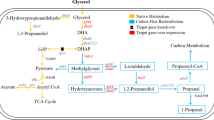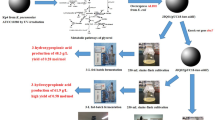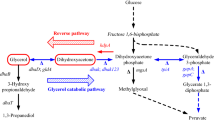Abstract
Klebsiella pneumoniae converts glycerol to the specialty chemical 1,3-propanediol (1,3-PDO), which is used for the production of polytrimethylene terepthalate (PTT). In this study, an NAD+-dependent gamma-glutamyl-gamma-aminobutyraldehyde dehydrogenase (PuuC) of K. pneumoniae DSM 2026, which oxidizes 3-hydroxypropionaldehyde to a platform chemical 3-hydroxypropionic acid (3-HP), was cloned and overexpressed in K. pneumoniae DSM 2026 for the co-production of 3-HP and 1,3-PDO from glycerol. In addition, the gene dhaT, encoding NADH-dependent 1,3-propanediol oxidoreductase (1,3-PDOR), was deleted from the chromosome for the balanced production of 3-HP and 1,3-PDO. The recombinant K. pneumoniae ∆dhaT, expressing puuC, produced 3.6 g 3-HP and 3.0 g 1,3-PDO per liter with an average yield of 81% on glycerol carbon in shake flask culture under microaerobic conditions. When a fed-batch culture was carried out under microaerobic conditions at pH 7.0 in a 5-l bioreactor, the recombinant K. pneumoniae ∆dhaT (puuC) strain produced 16.0 g 3-HP and 16.8 g 1,3-PDO per liter with a cumulative yield of 51% on glycerol carbon in 24 h. The production of 1,3-PDO in the dhaT-deletion mutant was attributed to the expression of NAD(P)H-dependent hypothetical oxidoreductase. This study demonstrates the feasibility of obtaining two commercially valuable chemicals, 3-HP and 1,3-PDO, at a significant scale.






Similar content being viewed by others
References
Ahrens K, Menzel K, Zeng A, Deckwer W (1998) Kinetic, dynamic, and pathway studies of glycerol metabolism by Klebsiella pneumoniae in anaerobic continuous culture: III. Enzymes and fluxes of glycerol dissimilation and 1, 3-propanediol formation. Biotechnol Bioeng 59(5):544–552
Blankschien MD, Clomburg JM, Gonzalez R (2010) Metabolic engineering of Escherichia coli for the production of succinate from glycerol. Metab Eng 12(5):409–419
Booth IR (2005) Glycerol and methylglyoxal metabolism. In: Neidhardt FC, Curtiss RIII, Ingraham JL, Lin ECC, Low KB, Magasanik B, Reznikoff WS, Riley M, Schaechter M, Umbarger HE (eds) Escherichia coli and salmonella: cellular and molecular biology (web edition). ASM, Washington, Available at http://www.ecosal.org
Bradford MM (1976) A rapid and sensitive for the quantitation of microgram quantities of protein utilizing the principle of protein-dye binding. Anal Biochem 72:248–254
Emptage M, Haynie S, Laffend L, Pucci J, Whited G (2001) Process for the biological production of 1,3-propanediol with high titer. E. I. du Pont de Nemours and Co. and Genencor International, Inc. U.S. patent WO 01/12833 A2
Ferguson GP, Totemeyer S, MacLean MJ, Booth IR (1998) Methylglyoxal production in bacteria: suicide or survival. Arch Microbiol 170:209–218
Global Renewable Chemicals Market (2009–2014). Available at http://www.marketsandmarkets.com/Market-Reports/renewable-chemicals-82.html
Hall RH, Stern ES (1950) Acid-catalysed hydration of acrylaldehyde: kinetics of the reaction and isolation of β-hydroxypropionaldehyde. J Chem Soc 490–498. Available at http://www.brdisolutions.com/pdfs/BioProductsOpportunitiesReportFinal.pdf
Jo JE, Raj SM, Rathnasingh C, Selvakumar E, Jung WC, Park SH (2008) Cloning, expression, and characterization of an aldehyde dehydrogenase from Escherichia coli K-12 that utilizes 3-hydroxypropionaldehyde as a substrate. Appl Microbiol Biotechnol 81:51–60
Johnson EA, Lin ECC (1987) Klebsiella pneumoniae 1, 3-propanediol: NAD+ oxidoreductase. J Bacteriol 169:2050–2054
Laemmli UK (1970) Cleavage of structural proteins during the assembly of the head of bacteriophage T4. Nature 227:680–685
Lin EC (1976) Glycerol dissimilation and its regulation in bacteria. Annu Rev Microbiol 23:573–580
Link AJ, Phillips D, Church GM (1997) Methods for generating precise deletions and insertions in the genome of wild-type Escherichia coli: application to open reading frame characterization. J Bacteriol 179:6228–6237
MacLean MJ, Ness LS, Ferguson GP, Booth IR (1998) The role of glyoxalase-I in the detoxification of methylglyoxal and in the activation of the KefB K+ efflux system in Escherichia coli. Mol Microbiol 27(3):563–571
Melchiorsen CR, Jokumsen KV, Villadsen J, Israelsen H, Arnau J (2002) The level of pyruvate-formate lyase controls the shift from homolactic to mixed-acid product formation in Lactococcus lactis. Appl Microbiol Biotechnol 58:338–344
Paster M, Pellegrino JL, Carole TM (2003) Industrial bioproducts: today and tomorrow. US DOE report, July, pp 48–49
Perez JM, Arenas FA, Pradenas GA, Sandoval JM, Vasquez CC (2008) Escherichia coli YqhD exhibits aldehyde reductase activity and protects from the harmful effect of lipid peroxidation-derived aldehydes. J Biol Chem 283(12):7346–7353
Raj SM, Rathnasingh C, Jo JE, Park SH (2008) Production of 3-hydroxypropionic acid from glycerol by a novel recombinant Escherichia coli BL21 strain. Process Biochem 43:1440–1446
Raj SM, Rathnasingh C, Jung WC, Park SH (2009) Effect of process parameters on 3-hydroxypropionic acid production from glycerol using a recombinant Escherichia coli. Appl Microbiol Biotechnol 84:649–657
Raj SM, Rathnasingh C, Jung WC, Selvakumar E, Park SH (2010) A novel NAD+-dependent aldehyde dehydrogenase encoded by the puuC gene of Klebsiella pneumoniae DSM 2026 that utilizes 3-hydroxypropionaldehyde as a substrate. Biotechnol Bioprocess Eng 15(1):131–138
Rathnasingh C, Raj SM, Jo JE, Park SH (2009) Development and evaluation of efficient recombinant Escherichia coli strains for the production of 3-hydroxypropionic acid from glycerol. Biotechnol Bioeng 104:729–739
Saxena RK, Anand P, Saran S, Isar J (2009) Microbial production of 1, 3-propanediol: recent developments and emerging opportunities. Biotechnol Adv 27(6):895–913
Seo MY, Seo JW, Heo SY, Baek JO, Rairakhwada D, Oh BR, Seo PS, Choi MG, Kim CH (2009) Elimination of by-product formation during production of 1, 3-propanediol in Klebsiella pneumoniae by inactivation of glycerol oxidative pathway. Appl Microbiol Biotechnol 84:527–534
Seo JW, Seo MY, Oh BR, Heo SY, Baek JO, Rairakhwada D, Luo LH, Hong WK, Kim CH (2010) Identification and utilization of a 1, 3-propanediol oxidoreductase isoenzyme for production of 1, 3-propanediol from glycerol in Klebsiella pneumoniae. Appl Microbiol Biotechnol 85:659–666
Severine FF, Bernard J, Christiane F (1995) Transformation of wild-type Klebsiella pneumoniae with plasmid DNA by electroporation. J Microbiol Methods 24:49–54
Stephanopoulos GN, Aristidou AA, Nielsen J (1998) Metabolic engineering: principles and methodologies. Academic Press, San Diego, California
Wang W, Sun J, Hartlep M, Deckwer WD, Zeng AP (2003) Combined use of proteomic analysis and enzyme activity assays for metabolic pathway analysis of glycerol fermentation by Klebsiella pneumoniae. Biotechnol Bioeng 83:525–536
Zhao L, Zheng Y, Xingyuan M, Wei D (2009) Effects of over-expression of glycerol dehydrogenase and 1, 3-propanediol oxidoreductase on bioconversion of glycerol into 1, 3-propandediol by Klebsiella pneumoniae under microaerobic conditions. Bioprocess Biosys Eng 32:313–320
Acknowledgments
This work was financially supported by the Korean Ministry of Commerce, Industry, and Energy (Grant No. 10028380-2006-11), and Korean Ministry of Education, Science and Technology through Advanced Biomass R&D Centre (ABC; Grant No. 2010-0029799), KAIST, Korea. Dr. S. M. Raj is grateful to the Brain Korea 21 program, Pusan National University for providing financial assistance.
Author information
Authors and Affiliations
Corresponding author
Rights and permissions
About this article
Cite this article
Ashok, S., Raj, S.M., Rathnasingh, C. et al. Development of recombinant Klebsiella pneumoniae ∆dhaT strain for the co-production of 3-hydroxypropionic acid and 1,3-propanediol from glycerol. Appl Microbiol Biotechnol 90, 1253–1265 (2011). https://doi.org/10.1007/s00253-011-3148-z
Received:
Revised:
Accepted:
Published:
Issue Date:
DOI: https://doi.org/10.1007/s00253-011-3148-z




